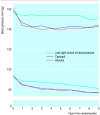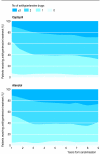Efficacy of atenolol and captopril in reducing risk of macrovascular and microvascular complications in type 2 diabetes: UKPDS 39. UK Prospective Diabetes Study Group - PubMed (original) (raw)
Clinical Trial
. 1998 Sep 12;317(7160):713-20.
- PMID: 9732338
- PMCID: PMC28660
Clinical Trial
Efficacy of atenolol and captopril in reducing risk of macrovascular and microvascular complications in type 2 diabetes: UKPDS 39. UK Prospective Diabetes Study Group
UK Prospective Diabetes Study Group. BMJ. 1998.
Abstract
Objective: To determine whether tight control of blood pressure with either a beta blocker or an angiotensin converting enzyme inhibitor has a specific advantage or disadvantage in preventing the macrovascular and microvascular complications of type 2 diabetes.
Design: Randomised controlled trial comparing an angiotensin converting enzyme inhibitor (captopril) with a beta blocker (atenolol) in patients with type 2 diabetes aiming at a blood pressure of <150/<85 mm Hg.
Setting: 20 hospital based clinics in England, Scotland, and Northern Ireland.
Subjects: 1148 hypertensive patients with type 2 diabetes (mean age 56 years, mean blood pressure 160/94 mm Hg). Of the 758 patients allocated to tight control of blood pressure, 400 were allocated to captopril and 358 to atenolol. 390 patients were allocated to less tight control of blood pressure.
Main outcome measures: Predefined clinical end points, fatal and non-fatal, related to diabetes, death related to diabetes, and all cause mortality. Surrogate measures of microvascular and macrovascular disease included urinary albumin excretion and retinopathy assessed by retinal photography.
Results: Captopril and atenolol were equally effective in reducing blood pressure to a mean of 144/83 mm Hg and 143/81 mm Hg respectively, with a similar proportion of patients (27% and 31%) requiring three or more antihypertensive treatments. More patients in the captopril group than the atenolol group took the allocated treatment: at their last clinic visit, 78% of those allocated captopril and 65% of those allocated atenolol were taking the drug (P<0.0001). Captopril and atenolol were equally effective in reducing the risk of macrovascular end points. Similar proportions of patients in the two groups showed deterioration in retinopathy by two grades after nine years (31% in the captopril group and 37% in the atenolol group) and developed clinical grade albuminuria >=300 mg/l (5% and 9%). The proportion of patients with hypoglycaemic attacks was not different between groups, but mean weight gain in the atenolol group was greater (3.4 kg v 1.6 kg).
Conclusion: Blood pressure lowering with captopril or atenolol was similarly effective in reducing the incidence of diabetic complications. This study provided no evidence that either drug has any specific beneficial or deleterious effect, suggesting that blood pressure reduction in itself may be more important than the treatment used.
Figures
Figure 1
Median systolic and diastolic blood pressure over nine years in patients allocated angiotensin converting enzyme inhibitor and β blocker in group assigned to tight control of blood pressure and in patients in group assigned to less tight control
Figure 2
Proportion of patients over nine years who required no drugs, one drug, two drugs, or three or more drugs for treating hypertension to attain target blood pressure
Figure 3
Kaplan-Meier plots of proportion of patients with any clinical end point, fatal or non-fatal, related to diabetes
Figure 4
Numbers of patients who attained one or more clinical end points in aggregates representing specific types of clinical complications, with relative risks comparing captopril with atenolol
Figure 5
Kaplan-Meier plots of proportion of patients who died of disease related to diabetes (myocardial infarction, sudden death, stroke, peripheral vascular disease, and renal failure)
Figure 6
Kaplan-Meier plots of proportion of patients who developed microvascular end points (mostly retinal photocoagulation), fatal and non-fatal myocardial infarction (including sudden death), fatal and non-fatal strokes, and heart failure
Figure 7
Numbers of patients who attained individual end points, with relative risks comparing captopril with atenolol
Comment in
- Diabetes: a time for excitement-and concern. Hopeful signs exist that the ravages of diabetes can be tamed.
Orchard T. Orchard T. BMJ. 1998 Sep 12;317(7160):691-2. doi: 10.1136/bmj.317.7160.691. BMJ. 1998. PMID: 9732333 Free PMC article. No abstract available. - Treating type 2 diabetes. Study was conducted in exemplary fashion.
Narayan KM, Beckles GL, Gregg EW, Williamson DF, Saaddine J, Engelgau MM, Vinicor F. Narayan KM, et al. BMJ. 1999 Mar 6;318(7184):666-7; author reply 668. doi: 10.1136/bmj.318.7184.666a. BMJ. 1999. PMID: 10066218 Free PMC article. No abstract available. - Treating type 2 diabetes. Difference needs to be explained.
Christiansen EH. Christiansen EH. BMJ. 1999 Mar 6;318(7184):667; author reply 668. BMJ. 1999. PMID: 10215364 No abstract available. - Treating type 2 diabetes. Important findings should not be published in two journals.
Richards J. Richards J. BMJ. 1999 Mar 6;318(7184):667-8. BMJ. 1999. PMID: 10215366 No abstract available.
Similar articles
- Tight blood pressure control and risk of macrovascular and microvascular complications in type 2 diabetes: UKPDS 38. UK Prospective Diabetes Study Group.
UK Prospective Diabetes Study Group. UK Prospective Diabetes Study Group. BMJ. 1998 Sep 12;317(7160):703-13. BMJ. 1998. PMID: 9732337 Free PMC article. Clinical Trial. - Hypertension in Diabetes Study IV. Therapeutic requirements to maintain tight blood pressure control.
[No authors listed] [No authors listed] Diabetologia. 1996 Dec;39(12):1554-61. doi: 10.1007/s001250050614. Diabetologia. 1996. PMID: 8960842 Clinical Trial. - Risks of progression of retinopathy and vision loss related to tight blood pressure control in type 2 diabetes mellitus: UKPDS 69.
Matthews DR, Stratton IM, Aldington SJ, Holman RR, Kohner EM; UK Prospective Diabetes Study Group. Matthews DR, et al. Arch Ophthalmol. 2004 Nov;122(11):1631-40. doi: 10.1001/archopht.122.11.1631. Arch Ophthalmol. 2004. PMID: 15534123 Clinical Trial. - Beta-blockers, diabetes, and hypoglycemia: risky business?
Levinson PD. Levinson PD. Med Health R I. 2001 Mar;84(3):81-2. Med Health R I. 2001. PMID: 11280134 Review. No abstract available. - Beta-blockers and diabetes: the bad guys come good.
Cruickshank JM. Cruickshank JM. Cardiovasc Drugs Ther. 2002 Sep;16(5):457-70. doi: 10.1023/a:1022146721098. Cardiovasc Drugs Ther. 2002. PMID: 12652116 Review.
Cited by
- Computational Insights into Captopril's Inhibitory Potential Against MMP9 and LCN2 in Bladder Cancer: Implications for Therapeutic Application.
Annana SK, Ferdoush J, Lamia F, Roy A, Kar P, Nandi M, Kabir M, Saha A. Annana SK, et al. Cancer Inform. 2024 Sep 19;23:11769351241276759. doi: 10.1177/11769351241276759. eCollection 2024. Cancer Inform. 2024. PMID: 39315330 Free PMC article. - Metformin for preventing the progression of chronic kidney disease.
El-Damanawi R, Stanley IK, Staatz C, Pascoe EM, Craig JC, Johnson DW, Mallett AJ, Hawley CM, Milanzi E, Hiemstra TF, Viecelli AK. El-Damanawi R, et al. Cochrane Database Syst Rev. 2024 Jun 4;6(6):CD013414. doi: 10.1002/14651858.CD013414.pub2. Cochrane Database Syst Rev. 2024. PMID: 38837240 Review. - Comparative Analysis of Biomarkers in Type 2 Diabetes Patients With and Without Comorbidities: Insights Into the Role of Hypertension and Cardiovascular Disease.
Savvopoulos S, Hatzikirou H, Jelinek HF. Savvopoulos S, et al. Biomark Insights. 2024 May 4;19:11772719231222111. doi: 10.1177/11772719231222111. eCollection 2024. Biomark Insights. 2024. PMID: 38707193 Free PMC article. - Risk Factors of Chronic Kidney Disease Progression: Between Old and New Concepts.
Mallamaci F, Tripepi G. Mallamaci F, et al. J Clin Med. 2024 Jan 24;13(3):678. doi: 10.3390/jcm13030678. J Clin Med. 2024. PMID: 38337372 Free PMC article. Review. - Supporting people with type 2 diabetes in effective use of their medicine through mobile health technology integrated with clinical care (SuMMiT-D pilot): results of a feasibility randomised trial.
SuMMiT-D Collaborative Group; Farmer AJ, Allen J, Bartlett YK, Bower P, Chi Y, French DP, Gudgin B, Holmes E, Horne R, Hughes DA, Jones L, Kenning C, Locock L, McSharry J, Miles L, Newhouse N, Rea R, Robinson S, Tarassenko L, Velardo C, Williams N, Yu LM. SuMMiT-D Collaborative Group, et al. Pilot Feasibility Stud. 2024 Jan 25;10(1):15. doi: 10.1186/s40814-023-01429-5. Pilot Feasibility Stud. 2024. PMID: 38273420 Free PMC article.
References
- Kasiske B, Kalil RSN, Ma JZ, Liao M, Keane WF. Effect of antihypertensive therapy on the kidney in patients with diabetes: a meta-regression analysis. Ann Intern Med. 1993;118:129–138. - PubMed
- Passa P, Leblanc H, Marre M. Effects of enalapril in insulin-dependent diabetic subjects with mild to moderate uncomplicated hypertension. Diabetes Care. 1987;10:200–204. - PubMed
- Laffel LM, McGill JB, Gans DJ. The beneficial effect of angiotensin-converting enzyme inhibition with captopril on diabetic nephropathy in normotensive IDDM patients with microalbuminuria. North American Microalbuminuria Study Group. Am J Med. 1995;99:497–504. - PubMed
Publication types
MeSH terms
Substances
LinkOut - more resources
Full Text Sources
Other Literature Sources
Medical






